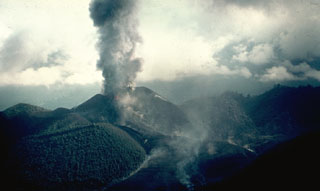Report on Carran-Los Venados (Chile) — July 1979
Scientific Event Alert Network Bulletin, vol. 4, no. 7 (July 1979)
Managing Editor: David Squires.
Carran-Los Venados (Chile) Eruption ends
Please cite this report as:
Global Volcanism Program, 1979. Report on Carran-Los Venados (Chile) (Squires, D., ed.). Scientific Event Alert Network Bulletin, 4:7. Smithsonian Institution. https://doi.org/10.5479/si.GVP.SEAN197907-357140
Carran-Los Venados
Chile
40.35°S, 72.07°W; summit elev. 1114 m
All times are local (unless otherwise noted)
The eruption of Mirador began violently on [14] April, but activity declined quickly to more moderate levels. Explosions and accompanying seismicity then gradually decreased in frequency and intensity until the eruption ended on 25 May. Ash deposits were 2-3 cm thick at the base of Mirador and ash fell as much as 20 km away. A small amount of lava (andesitic basalt in hand specimen) flowed NE and SE.
Further References. Moreno, H., 1980, La erupción del volcán Mirador en Abril-Mayo de 1979, lago Ranco-Rininahue, Andes del Sur: Comunicaciones, Universidad de Chile, no. 28, p. 1-23.
Geological Summary. The Carrán-Los Venados volcano group includes about 50 basaltic to basaltic-andesite scoria cones, maars, and a small stratovolcano that are broadly aligned along a 17-km-long ENE-WSW trend ESE of Lago Ranco. The volcanic features occupy a low-lying area N of the more topographically prominent Puyehue-Cordón Caulle volcanic chain, and many of the vents are postglacial in age. The Mirador scoria cone and two maars, Riñinahue and Carrán, were formed during eruptions in the 20th century. These historical eruptions were concentrated where the regional Liquine-Ofqui fault zone intersects the alignment of volcanic vents.
Information Contacts: O. González-Ferrán, Univ. de Chile, Santiago.

